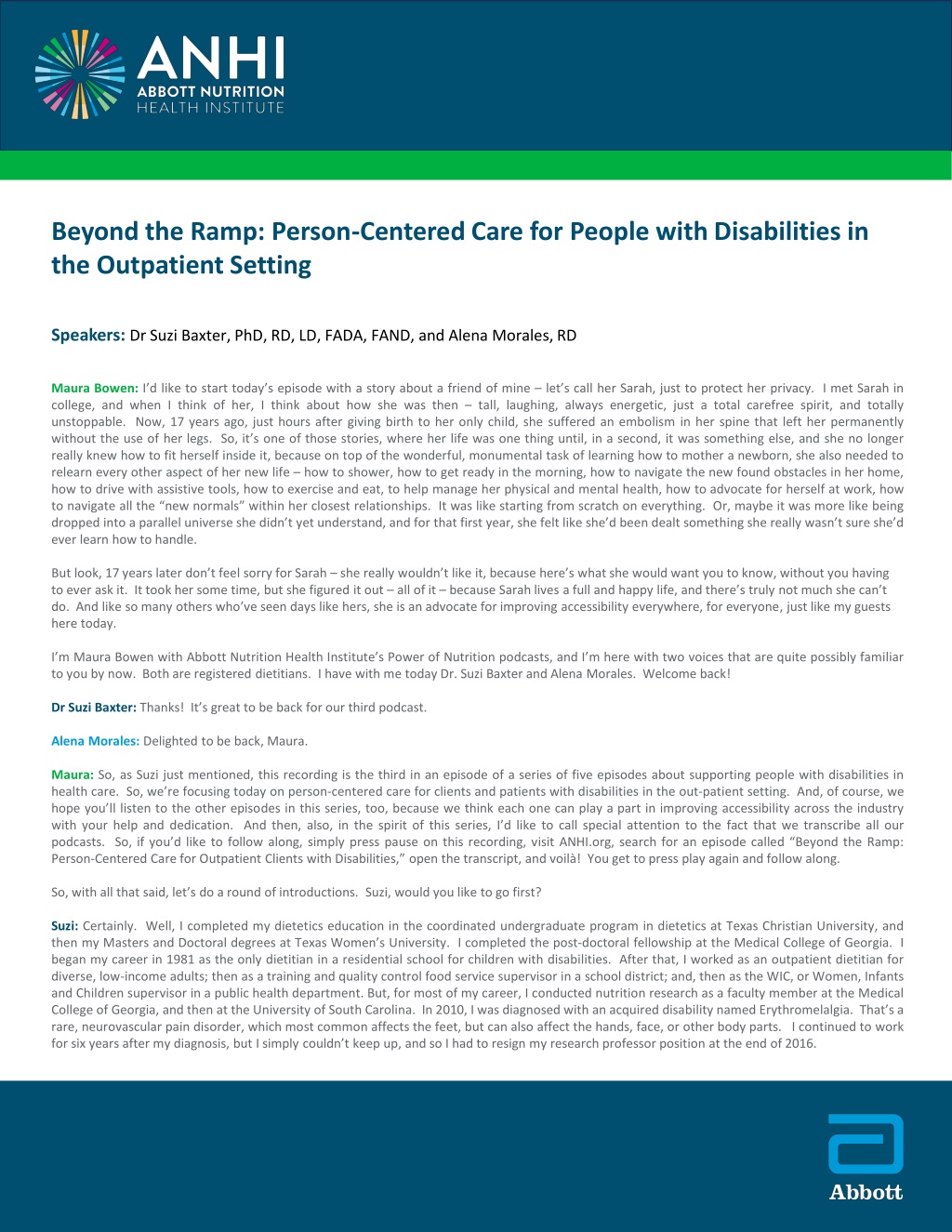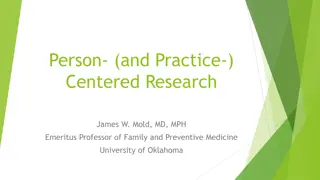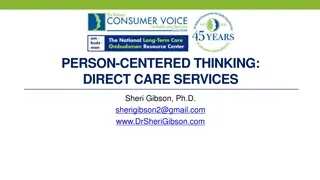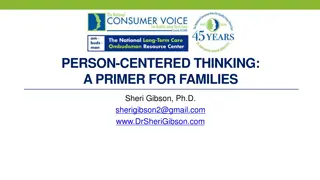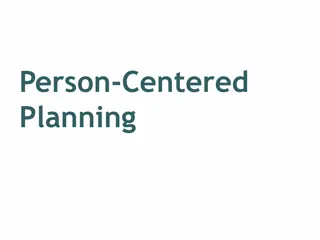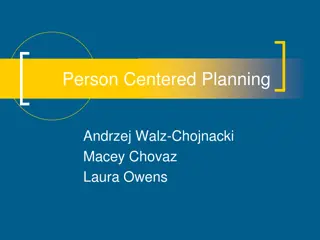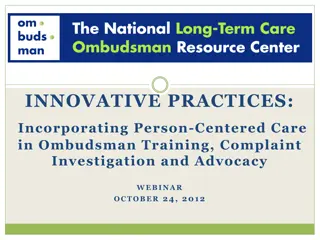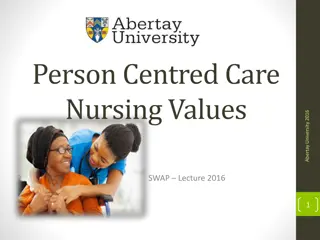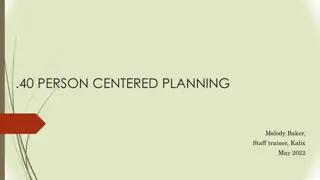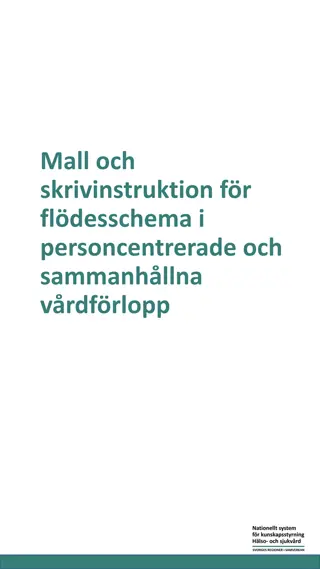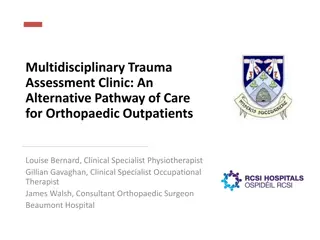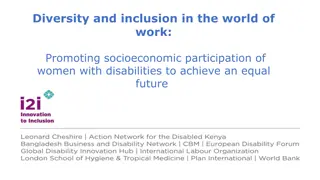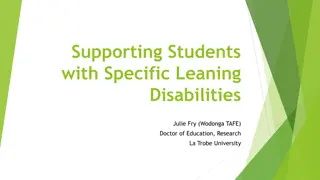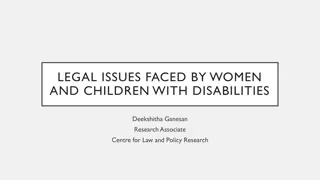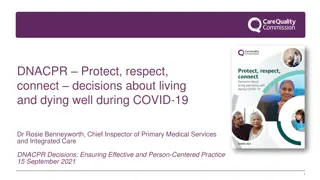Beyond the Ramp: Person-Centered Care for Outpatients with Disabilities
Maura Bowen shares Sarah's inspiring journey of adaptation after a sudden disability, highlighting challenges faced and victories achieved. In this podcast episode featuring Dr. Suzi Baxter and Alena Morales, the focus is on person-centered care for individuals with disabilities in outpatient settings. The speakers bring a wealth of experience and insight, emphasizing the importance of accessibility and personalized support in healthcare. Dr. Baxter's personal experience with a rare pain disorder adds a unique perspective to the discussion. The series aims to enhance inclusivity and improve healthcare practices for diverse populations.
Download Presentation

Please find below an Image/Link to download the presentation.
The content on the website is provided AS IS for your information and personal use only. It may not be sold, licensed, or shared on other websites without obtaining consent from the author. Download presentation by click this link. If you encounter any issues during the download, it is possible that the publisher has removed the file from their server.
E N D
Presentation Transcript
Beyond the Ramp: Person-Centered Care for People with Disabilities in the Outpatient Setting Speakers: Dr Suzi Baxter, PhD, RD, LD, FADA, FAND, and Alena Morales, RD Maura Bowen:I d like to start today s episode with a story about a friend of mine let s call her Sarah, just to protect her privacy. I met Sarah in college, and when I think of her, I think about how she was then tall, laughing, always energetic, just a total carefree spirit, and totally unstoppable. Now, 17 years ago, just hours after giving birth to her only child, she suffered an embolism in her spine that left her permanently without the use of her legs. So, it s one of those stories, where her life was one thing until, in a second, it was something else, and she no longer really knew how to fit herself inside it, because on top of the wonderful, monumental task of learning how to mother a newborn, she also needed to relearn every other aspect of her new life how to shower, how to get ready in the morning, how to navigate the new found obstacles in her home, how to drive with assistive tools, how to exercise and eat, to help manage her physical and mental health, how to advocate for herself at work, how to navigate all the new normals within her closest relationships. It was like starting from scratch on everything. Or, maybe it was more like being dropped into a parallel universe she didn t yet understand, and for that first year, she felt like she d been dealt something she really wasn t sure she d ever learn how to handle. But look, 17 years later don t feel sorry for Sarah she really wouldn t like it, because here s what she would want you to know, without you having to ever ask it. It took her some time, but she figured it out all of it because Sarah lives a full and happy life, and there s truly not much she can t do. And like so many others who ve seen days like hers, she is an advocate for improving accessibility everywhere, for everyone, just like my guests here today. I m Maura Bowen with Abbott Nutrition Health Institute s Power of Nutrition podcasts, and I m here with two voices that are quite possibly familiar to you by now. Both are registered dietitians. I have with me today Dr. Suzi Baxter and Alena Morales. Welcome back! Dr Suzi Baxter: Thanks! It s great to be back for our third podcast. Alena Morales: Delighted to be back, Maura. Maura: So, as Suzi just mentioned, this recording is the third in an episode of a series of five episodes about supporting people with disabilities in health care. So, we re focusing today on person-centered care for clients and patients with disabilities in the out-patient setting. And, of course, we hope you ll listen to the other episodes in this series, too, because we think each one can play a part in improving accessibility across the industry with your help and dedication. And then, also, in the spirit of this series, I d like to call special attention to the fact that we transcribe all our podcasts. So, if you d like to follow along, simply press pause on this recording, visit ANHI.org, search for an episode called Beyond the Ramp: Person-Centered Care for Outpatient Clients with Disabilities, open the transcript, and voil ! You get to press play again and follow along. So, with all that said, let s do a round of introductions. Suzi, would you like to go first? Suzi: Certainly. Well, I completed my dietetics education in the coordinated undergraduate program in dietetics at Texas Christian University, and then my Masters and Doctoral degrees at Texas Women s University. I completed the post-doctoral fellowship at the Medical College of Georgia. I began my career in 1981 as the only dietitian in a residential school for children with disabilities. After that, I worked as an outpatient dietitian for diverse, low-income adults; then as a training and quality control food service supervisor in a school district; and, then as the WIC, or Women, Infants and Children supervisor in a public health department. But, for most of my career, I conducted nutrition research as a faculty member at the Medical College of Georgia, and then at the University of South Carolina. In 2010, I was diagnosed with an acquired disability named Erythromelalgia. That s a rare, neurovascular pain disorder, which most common affects the feet, but can also affect the hands, face, or other body parts. I continued to work for six years after my diagnosis, but I simply couldn t keep up, and so I had to resign my research professor position at the end of 2016.
Maura: Thank you, Suzi. And how about you, Alena? Alena: Of course. As you may know from previous episodes, I acquired disabling chronic illnesses from a young age, and was later hit by a car. I came across the Disability Rights movement and its roots within Berkeley, California, and this inspired me to go to UC Berkeley for college to study dietetics and disability studies. While at Berkeley, I participated in the disability community there through many hats. I worked for the Disability Access and Compliance Office to help optimize physical, technological, and problematic access for people with disabilities on campus. I also engaged in disability activism by creating a new organization, developing wellness programs with students with disabilities, and creating one of the first disability cultural centers in the country. I later joined a three-year research project at the University of California, San Francisco, and we analyzed the impact of SNAP for SSI recipients. In 2021, I continued my education at Berkeley by attending their clinically focused, individualized supervised practice pathway, or ISPP for short. I received my RD in 2022, and now primarily work as a clinical dietitian in San Diego, California. Maura: All right, well thanks to you both. So, as we ve established in our previous two episodes, my friend, Sarah, is far from alone. There are so many different types of disabilities, and at varying degrees, so to help us get grounded a little bit, let s get into some data. What is the prevalence of disabilities in our country, and how does this impact health outcomes? Suzi: Good question. In the United States, 27 percent that s slightly more than one in four adults have some type of disability. Here are the percentages for adults by functional disability types, from most to least. 13 percent have a cognition disability, which means they have serious difficulty concentrating, remembering, or making decisions. Now many of these people actually work full time and have advanced degrees. 12 percent have a mobility disability. That means they have serious difficulty walking or climbing stairs or using their arms and hands. Seven percent have an independent living disability. That means they have difficulty doing errands alone. Six percent are deaf or have serious difficulty hearing. Five percent have a vision disability, with blindness or serious difficulty seeing, even when they re wearing glasses or contact lenses. And four percent have a self-care disability. That means they have difficulty with things like dressing or bathing. Alena: Now this data is self-reported in the Center for Disease Control and Prevention s Behavioral Risk Factor Surveillance System, and it classifies participants into six disability types, as Suzi just mentioned. This one is based on answering yes, just during questions concerning abilities, impairment, and difficulties managing activities in daily living. Now, it s important to mention that there are actually no questions regarding stigma, or another word for that is ableism, due to an impairment or difference. Now, these numbers are likely under-reported. The problems of disability within this data actually varies depending on the community you live in. For example, one in three people living in rural communities self-report having a disability. Research attributes this to additional barriers based in rural communities, such as lower socio-economic status, education barriers, access to health care, and more. These barriers are not limited to rural communities, however, and highlight how disability is both a cause and a consequence of compounding barriers in marginalized identities. 29 key statistics demonstrate that 22 percent of disabled people were considered poor under the Census supplemental poverty measure, compared with just over ten percent of non-disabled people. This is, of course, further perpetuated by additional identity factors, including, but not limited to: race, gender, or sexuality. Suzi: Thanks, Alena. Let s unpack this a little bit more and explore, say, the prevalence of disability in racial ethnic groups. Now, disabilities do occur in all racial ethnic groups. They don t discriminate. But the prevalence does vary by race ethnic group. It s greatest for the American Indian/Alaskan Native people as 30 percent. This is followed by Black people at 25 percent. Then come the White people at 20 percent, followed by native Hawaiian/Pacific Islanders as 17 percent, and Hispanics at 17 percent, and the prevalence of disabilities is the least for Asian people at ten percent. Now, being a member of a racial ethnic minority and having a disability is a double burden. For example, people who are Black, indigenous, or persons of color or that s the acronym, BIPOC and have mobility disabilities have poorer physical and mental health outcomes than White people with disabilities. Black individuals account for almost 25 percent of spinal cord injuries in the United States, but they make up just 13 percent of the population. Almost 40 percent of Black Americans with a disability live in poverty, compared to 29 percent of non-Hispanic Whites and 24 percent of White.
Alena: Of course, several systems play a role in the relationship between disability, compounding social identities, and poverties, and we could, of course, sit here all day exploring that, but I ll just give you some examples. It s more expensive to have a disability, not just due to increased medical costs, but also due to increased cost of living for accessible housing, disproportionate access to accessible transportation, and extremely limited asset limit for SSI recipients. And this does not just impact unemployed people with disabilities. Even if you work, employees with disability make, on average, 74 cents to every dollar paid to non-disabled peers. Suzi: And, disability has implications for health, because adults with disabilities are much more likely to have obesity, heart disease, and Diabetes, and to smoke. Here are the specific comparisons for each of these. 42 percent of adults with disabilities have obesity, compared to only 30 percent of adults without disabilities; ten percent of adults with disabilities have heart disease, compared to only three percent of adults without disabilities. 16 percent of adults with disabilities have Diabetes, compared to only eight percent of adults without disabilities. And 22 percent of adults with disabilities smoke, compared to only 11 percent of adults without disabilities. Alena and I could keep going, but this basic data is a good place to start to understand the relationship between the societal barriers and health outcomes for the disabled community. Maura: Yes, thank you. That data was really helpful in helping us better understand the scope, specifically here in the United States, but you get a sense globally, as well. And I know that, we ve also talked in previous episodes, about what it means to live in a world that s made for the masses, which, sometimes and sometimes doesn t quite offer what people with disabilities need. So, I m wondering if you could tell us a little bit about what some barriers are that people with disabilities might face as outpatients when they re trying to access care. Suzi: Well, certainly. Among working age adults, there are many barriers to outpatient health care access, and specifically, these include 25 percent that s one in four adults with disabilities, ages 18 to 44 years lack a usual health care provider. 25 percent of adults with disabilities, aged 18 to 44 years, have an unmet health care need, due to cost in the past year. And 20 percent, or one in five adults with disabilities, aged 45 to 64 years, did not have a routine check-up in the past year. And the barrier of nutritional health is still limited to diversity of the dietetic work force. In the United States and its territories, dietetic practitioners are 68 percent White, 13 percent BIPOC, and 19 percent race not reported, but less than four percent of dietetic practitioners who are employed have a disability. In contrast, our nation s population is 38 percent BIPOC, and 27 percent of adults have a disability. Alena: Thank you for presenting that important data, Suzi. Now, since the disability community is so vast, we could name thousands of barriers faced when trying to access case. But, when thinking about outpatient heath care barriers for the disability community, or really barriers for any type of environment, I would suggest you start by considering the eight main types of barriers for people of disability. The first main barrier are attitudinal barriers. A recent study that analyzed the attitude towards people with disabilities amongst physicians posed a few interesting statistics, and I ll share two quantitative examples with you. Only about half of physicians strongly agree that they would welcome patients with disabilities in for their practice. And, more than four-fifths of physicians reported that people with significant disability have worse quality of life than non-disabled people. People with disabilities are three-dimensional people with feelings and opinions, so reducing their experience to a limitation or impairment can be both invalidating and inaccurate to the clinical picture. Now, we ve touched upon the concept of disability cultural competency in the previous episode, and I ll dive into that a bit to like conceptualize one example of an attitudinal barrier. For example, the language preferences of people with disabilities vary widely. Some people prefer people first language to describe disability, such as people with disability, while others prefer identify first language to describe themselves, such as disabled people. There are, however, terms that the disability community has largely accepted to be harmful, such as the term, wheelchair bound, as opposed to wheelchair user. If you, as a provider, use this harmful language, you have created a barrier by losing the trust and comfort of your patient. The second main type of barrier are communication barriers. Deaf or hard of hearing patients may experience barriers to care, because a clinic does not offer American Sign Language interpretation sources or live CART caption translation. (CART captioning can be defined as communication access in real time translation.) Or if they do offer these services, they may not be well-known to staff due to lack of training, or if offered on an iPad, not
Alena: technologically reliable. With this barrier in place, the provider is unable to efficiently gather important data from the patient and the patient may not be able to get their questions about the medical intervention answered. The patient may also not be able to properly advocate for themselves during the appointment without the proper communication accommodation. Another type of barrier are physical barriers. Lack of physical access to outpatient clinic impacts care in more ways than just entering the space. If you have things like insufficient specialized equipment, this can prevent people from being weighed and receiving proper exam; therefore, essential pieces of clinical information are missed. The fourth type of barrier are programmatic barrier. Consider the myriad of programs within health care and how these can pose a barrier. For example, if there is, let s say, a preventative medicine program. If this is made without the consideration of accommodations and disability culture, then patients with disabilities will not be able to access it. Think about the statistics Suzi mentioned earlier regarding disability and higher rates of obesity, heart disease, smoking, and Diabetes. Accessibility in disability inclusion is recognized for what it is a facet of preventative medicine. Consider how training programs also for health care professionals do not typically include education about disability culture and how this can create attitudinal barriers toward people with disability. The fifth main type of barrier are barriers within policies and procedures. Think about Suzi s earlier point about how one in four people with disabilities have an unmet heath care need due to cost. Now, this is not just a coincidence. It s actually exacerbated by programs in place that prevent disabled people from accruing wealth. Let s consider an example I mentioned earlier, which is the asset limit for SSI recipients. People with disabilities, who are unable to work and receive SSI, currently cannot own more than $2,000.00 in cash and assets not including your home. And, if you and your spouse have a disability and are on SSI, this number is further constricted to $3000.00 between the two of you. So, this policy limits people with disabilities from saving for medical emergencies or expensive medical interventions, which can increase quality and duration of life. Thankfully, in September, 2023, the Savings Penalty Elimination Act was actually proposed, and this would increase this limit to $10,000.00, which would improve the situation, but as we all know, this doesn t go a long way towards health care bills. Next are social barriers. Accessibility and disability cultural competency is undoubtedly a social determinate of health. The data we mentioned earlier is important for understanding how existing societal structures create this disproportionate health outcome for people with disability. The seventh type of barrier are technological barriers. We will discuss this more in episode five of our podcast, so I won t include any spoilers here. And the eighth, and final, main type of barrier are transportation barriers. Having a lack of safe, efficient, and accessible transportation can impact the ability for a patient with disability to access care. For example, if the nearest bus stop to an outpatient clinic is located at the top of a hill, it may be too steep for a wheelchair to easily roll down it, therefore, creating barriers to entering the building. I know this was a lot, but overall, it s important to note that people often experience multiple barriers at once, therefore compounding the distrust in the healthcare space, and possibly leading to multi-factorial negative health outcomes. These barriers may also impact disabled employees, thus perpetuating a stigmatized work environment. Consider the many types of barrier people with disabilities face, and how not contemplating these barriers can impact your ability to gather important clinical data. Also, it can lower medical compliance and even dissuade people with disabilities from pursuing medical care in the first place. Maura: So, I m sure you both have thought about this next question quite a bit. In your mind, what are some of the most important things health care professionals can do to help ensure people with disabilities have the best patient experience possible in an outpatient setting? Suzi: Well, during the previous podcast in this series, we summarized Sections 504 and 508 and the proposed revisions to Section 504. Now, we anticipate that these laws will change and be stronger concerning accessible web sites, apps, and kiosks, as well as accessible health care facilities. Now, most medical facilities do have parking for people with disabilities. A rule of thumb utilized by Certified Access Specialists, the consultants Alena mentioned in the previous episode, is to have ten percent of parking spaces designated for people with disabilities. However, considering that at least 27 percent of the population has a disability, there often are not enough of these parking spaces, and they may not be as close to the doors to enter the building as desired.
Suzi: Likewise, most medical facilities have ramps to enter the building via doors that open automatically or by pushing a button. However, many buttons to open the doors are not located in very user-friendly spots, and many of the automatic doors close more quickly than needed, especially when people without disabilities are using the doors at the same time as people who use mobility devices. Now, there are hazards to ramps that must be considered. One would be potholes or cracks at the bottom of ramps. These can cause people to fall out of their mobility devices and be injured. Also consider the hash marks that are painted on the surface of the parking lots and streets. These are crucial for people with disabilities to cross to access the ramps. However, if these paths are shaded by trees or awnings, flashing lights may need to be added so that drivers can see when the crosswalks are being used and avoid hitting these people. Now, consider, too, that people with disabilities have teeth and eyes, and they need to be examined regularly by dentists and eye doctors. Think of the places where you go for your dental and eye exams. Were there ramps for people who use mobility devices to access the buildings? Was there space inside the exam rooms to maneuver a wheelchair or scooter? Did the chairs adjust in height so people in wheelchairs could transfer to and from their wheelchairs? And did the chairs have safety bars so people would not fall out of them. Accessibility must go beyond the ramps so that people with disabilities can receive the same standards of health care as people without disabilities. Here are some other things to consider: how high is the counter or window where patients check in after arriving? It should be no higher than waist high so that people in wheelchairs or scooters can see the receptionist and vice versa. Unfortunately, some health care facilities have counters that are chest high, which makes the process of checking in inaccessible for people who use mobility devices. In the waiting area, is the furniture arranged in a manner with aisles that are wide enough for people who use mobility devices to go through without taking souvenirs, such as people s toes, or some of the chairs, or even some of the tables in the waiting area. Does the door from the waiting area to the provider area open automatically or have a button to open it? Does this door open in the direction to allow the most space for people who use mobility devices? Is there an accessible scale to weigh people who use wheelchairs or mobility devices? It s simply not equitable to not weigh these people? What protocol is used to measure height without a stadiometer? Research shows that recumbent yields the most accurate height. Are there exam tables with adjustable height where people who use wheelchairs can transfer to and from the exam table and be examined? Again, it s not equitable to not examine these people. Are screening tools and questionnaires digitally accessible? Are physicians notes and reports digitally accessible? As Alena mentioned, we will discuss digital accessibility during episode five of this podcast series. Alena: Thank you, Suzi. That was very helpful. Now, as Suzi summarized, it s important to consider various degrees of access needs for health care. And, really, it boils down to integrating accessibility and disability inclusion in your regular thought processes. There are definite resources out there to help facilitate this, and like most government resources, they have positives and negatives. The U.S. Access Board sub-committee, for example, works along ADA requirements to create guidelines for health care specific accessibility standards. Among other projects, they have released access standards for exam tables and chairs, weight scales, radiological equipment, and mammography equipment. They have also released non-mandatory recommendations for tactile cues on prescription drug container labels to make them more accessible to people who are blind or have low vision. Another major initiative to consider is the CDC s Disability and Health Resources for Facilitating Inclusion and Overcoming Barriers. This is an online guideline that may be helpful to you because it talks about the types of barriers people with disabilities typically face in various spaces, including health care facilities. If you are a health care provider, there are helpful resources on things such as accessible fitness for people with disability, food access resources, training module for disability etiquette, and much more. If you are a health care administrator or program coordinator, you may benefit from their resources, such as Best Practices to Implement the ADA Guideline on Physical and Programmatic Regulations for Health Care Facilities, materials to train staff members on specialized medical equipment designed for people who use wheelchairs, and much more.
Alena: Learning the knowledge of disability culture, also known as disability cultural competency, is essential, not just to empathize with your patients and validate their experience, but also to lead to better patient outcomes. The spoon theory of disability is a great way to conceptualize this. Now, the spoon theory is a popular way of describing one s band width within the disability community. Each spoon represents a finite unit of energy that is spent each time a person does an activity, such as dressing, showering, preparing food, etc. In theory, able bodied people have an unlimited amount of spoons; but, people with disabilities may have a limited amount of spoons that result in them having to prioritize them and can spend them more intentionally. Extra spoons may also be spent addressing access barriers, therefore decreasing the overall spoon budget. It s basically become colloquial shorthand within the disability community. Discussing spoon theory in a similar fashion as the pain scale may help empower patients to conceptualize their fatigue to their provider. It can also help you, as the provider, better empathize with non-compliant patients. Imagine how many spoons it takes for a complex patient to manage their medication, exercise daily, and cook nutritious meals. Speaking from professional and personal experience, empathizing with patients with disabilities in this type of way will make the appointment much more positive, and help you more efficiently gather the data you need to suggest intervention. Now, I would say that the outpatient setting poses many opportunities to make or break a relationship with a patient. I suggest you start by reflecting on your existing attitudes towards disability and how it impacts your health care delivery. What s supposed to pop into your head when you think of disability? When you notice that your new patient has cerebral palsy, for example? Do you build preexisting assumptions about their abilities based on their diagnosis? Perhaps a neurodivergent patient no longer feels welcome in your office because you do not provide a sensory friendly waiting room, and they walk out before getting labs which reveal that their hemoglobin A1C is significant for pre-Diabetes. Consider the ways in which your outpatient care style demonstrates patient bettered care in general. Are there ways to infuse disability culture into these methods? Perhaps you may find cross-cultural health care delivery model to be helpful. Take the LEARN model patient care framework, for example. LEARN stands for listen, explain, acknowledge, recommend, and negotiate. Did you properly listen to and build empathy for a disabled patient s experience? Did you explain a concept in accessible, non-academic language? Did you properly acknowledge existing access barriers that may prevent your patient from feeling comfortable in your clinic? How can your recommendations consider a patient s access need? And how can you collaborate with your patient to create the most sustainable care plan? Patients on disability know their bodies and their needs as they deal with them 24/7. Health interventions and preventative care medicine only work if the patient feels embraced enough to pursue them. Maura: We talked for a moment about the prevalence of disabilities here in the United States and the overall impact on health outcomes. But, let s think specifically about nutrition now. In what ways might having a disability impact nutrition status? Suzi:That s another good question, Maura. People with disabilities certainly eat or receive nourishment in some manner or other, and there are many ways that having a disability impacts nutrition status. If we want to use spinal cord injuries as an example, their nutrition status can be impacted many ways, such as in the skin, bladder, bowel, circulation, hydration, body composition, inflammation, and mind and energy. In the acute stage, or the first four weeks after a traumatic spinal cord injury, ten to 20 percent of body weight is actually lost, and of this, 85 percent is lean muscle. There is obligatory negative nitrogen balance, which does not turn to positive balance until seven to eight weeks post-injury. Actual energy needs are at least ten percent below predicted needs, and dysphasia and nutrition status correlate significantly. On average, swallowing status starts to improve about one to two months after injury. And then later, during the chronic stage of spinal cord injury, nutrition status can be impacted by things such as delayed colon transit time, constipation and incontinence, energy intake is lower, and basal metabolic rate is lower, but there s a higher rate of obesity than the general population. There s also a greater burden of cardio-metabolic diseases, and indicators of metabolic syndrome. There s a decreased ability to use fat for energy due to decreased function of the autonomic nervous system. There can be irritable bowel symptoms and neurogenic osteoporosis. Muscle atrophy and obligatory sarcopenia mean less storage area for carbohydrate, which increases circulating glucose and the risk for Type 2 Diabetes. Alena: Thank you so much for that data, Suzi. Now, as we both kind of summarized, disability can either be a cause or consequence of food security and nutrition status. People with disabilities experience increased food inaccessibility. Rates of under-specified food security is approximately 28 percent in households with at least one unemployed disabled member, compared to only seven percent of able-bodied households. If that household member is employed, this number drops down to 24 percent, which is still extremely high. Very low food security, specifically, is actually five times
Alena: ...higher amongst people with disabilities, compared to able-bodied households. And, lets say that you have a well-paying job: even if you make three times more than the poverty income level, you are still six percent more likely to be food insecure than an able-bodied household. The relationship between disability and food insecurity have not been well-defined in literature as of 2020, but we can, of course, identify many causes based on the disproportionate access to money and wealth by the disability community. What we do know is that disproportionate access to a basic need, such as food, have been shown to actually decrease adherence to medical and nutritional interventions recommended by clinicians. And, as we know, disability is a full-time job. It can take a lot of time to manage symptoms and medical equipment, navigate barriers, advocate for yourself, and complete tasks. And this can impact nutrition status through many factors, such as decreased energy to cook; you re unable to walk and earn money for food; you have feeding difficulties, sensory needs that may restrict food, and more. Consider the spoon theory that we discussed earlier, and how a limited amount of energy may impact the ability to cook, purchase food, and think about nutritional intake. And this is not just limited to adults. Children with disabilities, for example, are three times more likely to have malnutrition, and two times more likely to die from malnutrition than children without disability. The Feeding and Disability Resource Bank is an important resource for nutrition professionals working with children with disabilities. It provides manuals, job aids, training curricula, and research articles on how to identify, manage, and support alternative feeding needs. Maura: And going a step further how can high prevalence of disabilities in this country impact the ability to carry out dietary interventions? Suzi: Well, as Alena mentioned previously, disabilities impact people 24 hours a day and seven days a week. Disabilities, in and of themselves are quite diverse, and they may affect and individual s vision, movement, thinking, remembering, learning, communicating, hearing, mental health, food procurement, food preparation, eating and drinking, and/or social relationships. Disabilities impact how people receive and understand nutrition or dietary guidance. Now, we all know that patient-centered care is crucial, so it s best to ask the individual person with a disability, could you please help me understand the ways you accommodate your disability ? And, remember, you may need to ask this question several times concerning different settings. For example, shopping, home and kitchen, for eating out. Alena: Suzy is absolutely right. Dietary interventions must consider the individualized needs of people with disabilities. The high prevalence of disability, and the subsequent relationship between disability and nutrition status, it means that there s an extremely high stake when creating nutrition interventions. A health care system that does not consider disability in dietary interventions prevents people with disabilities from benefitting from our expertise. And this inadvertently increases rates of chronic disease, raising distrust between the disability community and the nutrition professional, and it can further perpetuate systemic barriers faced by people with disabilities. I would say that the high rate of disability, however, also poses opportunities. The disability community is quite creative, and has already started to engage in inter-dependence with each other in order to address nutritional needs through mutual aid programs and community organizing. This high rate of disability means that the disability community is strong, and might, and it can claim experience we have relied on each other a lot to ensure that our nutritional needs are met, and through helping each other with things like grocery shopping, cooking, and more. For example, I had a friend in college who was blind, and I, myself, in college used a wheelchair, and often we would go grocery shopping or go eat together, and I would help by giving her visual cues in describing the food, and she would help me by getting things off the top shelves or moving chairs around or other access barriers. These types of examples aren t just individual specific they re all over the community. Disability centered organizations, for example, such as the Center for Independent Living, have created grocery shopping and meal assistance programs during the pandemic. And this was to ensure that immunocompromised community members receive nutritious food. Local disability justice organizations within the Bay area, for example, gathered money for meal trains and personal protective equipment to wear during transit, and grocery shopping. And this is not just pandemic specific, actually. In San Diego, we have a local disability community center made by disabled people for disabled people, and it has existed for the past 100 years. And we often host dinners and parties with food at no cost. Although these organizations have not made a nationwide impact on statistics,
Alena: ...imagine how this community organizing has prevented many people in the disability community from going hungry. And this was because of the high prevalence of disability, not in spite of it. Maura: So, with all that said, how can clinicians support the needs of individuals with disabilities in the outpatient setting so they can carry out dietary interventions and recommendations? Alena:That s a really good question. So, accommodating and embracing a patient s disability is essential to creating sustainable dietary interventions. Consider the ways in which you already do this for other communities. If you have a client who struggles with money, you would provide a meal plan that features expensive ingredients, fancy cooking equipment, or items at more pricey grocery stores. It s a similar though process with disability. If you collaborate with your client by understanding their need and integrating the into your nutrition intervention, they will have the ability to maintain the intervention and implement it independently, thus increasing compliance. Consider how you make your nutrition education and counseling session more inviting to a disabled client. Think of things like disability justice and culture, and how your client s experience may interact with those. There are also many specialized tools and accommodations that you can implement in your intervention. Suzi will now describe a few. Suzi: Thanks, Alena. Adaptive kitchen tools and utensils can make food preparation, cooking, and eating easier for people with disabilities. They help people with disabilities prepare, cook, and eat food independently, and with dignity. These items can be purchased from Amazon, supermarkets, and other stores. Let me share a few examples. Swivel utensils help people with little or no muscle control to keep food on the fork or spoon, which swivels with movement to keep a level platform before it enters the mouth. Easy grip utensils have larger handles for easier gripping. Easy grip utensils can be weighted or non-weighted. The weighted utensils or commonly used by people with Parkinson s Disease or other conditions with tremors to help control unsteady hands while eating. There are angled utensils that are light weight and bent to promote independent eating. There are also grip straps that can be attached to forks or spoons. The strap slides over the hand or the wrist so the person can hold the utensil without squeezing it. These grip straps help a person with limited hand movement or weak grip. There is something called Liftware, which has either stabilizing or leveling handles and rechargeable batteries, which will last about one hour, which is about three meals. They have spoon and fork attachments that come off and are dishwasher safe. You have probably already seen the lipped plates, which are plates with edges that round up so people can scoop food onto their utensils easier. The lipped plates are commonly used by individuals with poor hand coordination. You may have already also seen a rocker knife. That s a large knife that rocks back and forth while cutting, instead of sawing food. A rocker knife can reduce the risk of cutting oneself during food preparation because you don t have to pick up the knife between cuts. You may be familiar with non-skid mixing bowls. These are useful for people with only one hand, or with shaky hands. The non-skid material from the bottom of the bowls helps the bowls stay put during preparation tasks, such as mixing. Spout cups are used by people who have poor mouth control or may spill frequently. Often, these cups have lids, and the people suck, rather than drink, the liquids from them. Openers may be manual or automatic, and they re used to open jars, bottles, and cans. They may have grippers, cork screws, and other mounted openers. Food choppers are an easy way to cut food without using a knife. They help people who have weak or shaky hands.
Suzi: Bump Dots are available in various sizes and colors. Bump Dots are used for tactile marking of everyday items like ovens, keypads, computer keypads, and telephone keypads. Now some Bumps blind and sighted people use clear dots so that they don t obscure the display of the keypad. And for those with low vision, use black dots on a white background or vice versa, or fluorescent orange dots on a patterned or darker background. In addition to these adaptive kitchen tools and utensils, there are sanitation and cross-contamination considerations. Think of a cook who uses a manual wheelchair, who cuts up meat and then self-propels the wheelchair to the cooktop that cooks the meat. There s also a recent book out in 2023, called Crip Up the Kitchen: Tools, Tips, and Recipes for the Disabled Cook by Jules Sherred. Now, Jules says that the kitchen is the most ableist room in the house. Jules prepares everything from scratch, and the book aims to make the kitchen accessible and enjoyable with 50 recipes that make sure of three key tools: an electric pressure cooker, an air fryer, and a bread machine. The book includes pantry preparation, meal planning, shopping guides, kitchen organization plans for preparing and cooking food while using a wheelchair, and tips for cooking safely when disabled. The book takes into account varying physical abilities and energy levels, or daily spoons as Alena explained earlier. And it provides a step-by-step guide to safe canning and a template even for preparing your freezer and pantry for post-surgery. The book has rich photography and food histories, complete nutritional information, and methods developed for the disabled and neurodivergent cook. Maura: I love the fact that you mentioned Crip Up the Kitchen, the cookbook that were just speaking of that sounds like a wonderful resource. What resources are available for clinicians, and health care students and interns, to help support implementing these interventions? Suzi: Well, Alena mentioned several resources when she was speaking, and another one that I ll add is the National Center on Health, Physical Activity, and Disability. That acronym is NCHPAD. It provides some materials and videos on its website, and those are quite helpful. I will mention, too, that a goal of our Disabilities Member Interest Group is to create and make more resources available that are accessible, and to educate and encourage food companies to do the same. Maura: Thank you both, again, for this episode. Your information was incredibly helpful. Suzi: Oh, you re welcome. Thanks for having us. Alena: Yes, we re very happy to be here and share. Maura: Now, in our next episode, we ll talk about person-centered interventions for clients and patients with disabilities in the in-patient setting. But, in the meantime, if you re looking for more podcasts and their transcripts, we have dozens and dozens across a variety of different nutrition science topics, and you can find them on ANHI.org by clicking resources at the top of the page, and then podcasts. We are also on Spotify and Apple podcasts, so be sure to subscribe to ANHI s Power of Nutrition Podcast series to hear the latest nutrition science news and share it with your colleagues. Thanks, everyone!
